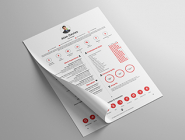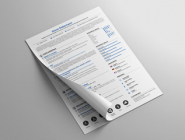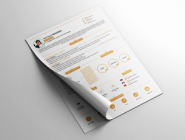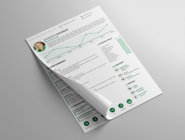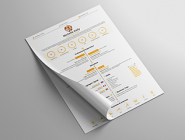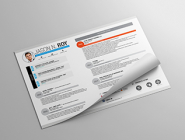Why Your Resume Format is Important
As you probably know, whether you get a job interview or not will depend greatly on the information you include in your resume. What you might not realise is how you format it is just important as what you include in it. The format of your resume will determine how the hiring manager or recruiter perceives you as a potential employee – it is their first glimpse at you on both a professional and personal level.
The format of a resume is also important as it helps to capture the attention of the hiring manager or recruiter. Most in their position only have a short amount of time and are only able to skim over your resume, so you should see it as crucial that you put the most important information in the places that will be easily seen. Avoid hiding all your best qualities and skills deep inside your resume.
It is important that you understand that there are various different resume formats and each highlight different parts of your professional accomplishments and skills. When you get an interview for a job, that is when you can discuss yourself professionally and personally in greater detail, but you should use your resume to show only the stand out parts. So if you want to make a big impact and good first impression on recruiters, you need to choose the best resume format, the one that showcases your professional experience and history best.
Most Common Resume Formats
There are three resume format types that are used most commonly – functional, chronological and hybrid (also referred to as combination). Each of these types of resume format highlight different areas of your professional history and have a specific purpose.
1. Functional Resume
The functional and chronological (further down the page) are essentially opposites of each other. The functional format, unlike the chronological variation, forgoes focusing on your work history and instead focuses on your accomplishments and skills. Traditionally, this particular format is not as popular with recruiters as the chronological resume. The only real reason you should even think about using a functional resume, if you have a standard career path, is if you have around 10 or more years work experience under your belt. It could be that even with that much work experience though, that if you use a functional resume, recruiters will see it and just consider you too under-qualified for the position.
An example of Functional Resume
This particular format does work well though, if you have a non-standard career path. This is because it can be used effectively by those who have changed jobs regularly or have been unemployed for a number of years. It not only highlights your best attributes on a professional level, but also will cover as best as it can, any gaps in your employment.
Far from being a bad choice, a functional resume needs to be done to a high standard for it to make that best first impression. Your skills need to outweigh your actual level of work experience and be impressive. To ensure that your professional history is completely clear to the recruiter you need to include dates on your functional resume.
How To Write A Functional Resume
Contact information
Regardless of what type of resume format you choose, this part remains the same. Be sure to include all of your up to date and current contact information.
Qualifications
This is probably the biggest difference between a functional and chronological resume, as the Qualifications section is the main highlight of a functional resume, in the same way (as you will see) that the Work Experience section is in a chronological resume. As the functional resume is supposed to shift the focus away from your work experience to your actual qualifications, this section should blow the other out of the water. You need to ask yourself “what experiences do I have in life that make me particularly qualified for this position?” and “what projects have I been involved in, represent my abilities and show them in the best light?”.
Skills
It is important to note that skills are a very different thing to actual qualifications. Skills are the tools you have worked on and honed over the years, while qualifications are the certifications, events and projects you have worked on. Much like contact information, this section is the same regardless of the resume format you choose to use. Use this section as a place to put as many keywords from the job posting as you can.
Professional Experience
By placing the professional experience section closer to the bottom of the first page, you are making them less noticeable. It is crucial though that you do not try to hide them any more than that. Always be completely clear when a job started and ended and include all the dates. If you lie, potential employers will find this out when they check your references to verify information you have put in your resume. The aim is not to lie, but show yourself in the best possible light.
Education
If you are a new graduate, you can easily swap this section for the Professional Experience section. List your education in reverse chronological order.
2. Chronological Resume
This is by far the most traditional, commonly used and most widely accepted resume format. This is largely because it lays out all of your experience in an ordered and clear manner. Although it is referred to as a chronological format, it actually lists your education and experience in a reverse-chronological fashion, with the most recent entry first. For instance, if you have a master's degree, you should list that first and above your bachelor's as it happened ,pre recently. Listing things in reverse-chronological order allows recruiters and employers to see your highest and most impressive achievements first.
An Example of Chronological Resume
As it has a very basic and traditional layout it can accommodate most industries. The chronological format focuses largely on dates and any growth in your career that you have had. This is the resume format that places your employment history in the highest regard. Because it is the most straight to the point and concise, it is easier for a hiring manager or recruiter to read and understand. After all, it is rare that any recruiter would actually spend the necessary time to “hunt” for information they are looking for in a resume.
How To Write A Chronological Resume
Contact Information
In much the same was as any resume format, this is a very important section and should include all of your most up to date and current contact information. This section does not change from one resume format to the other.
Summary Statement
Although a summary statement is not necessary on a resume, it can often be a useful addition. Please note that a summary statement is different to an objective statement as it describes your job market value in terms of your accomplishments and skills. Objective statements describe more what you hope to achieve and learn. An objective statement is only recommended in combination with a summary statement if you are moving into a new field. Your summary statement is your chance to explain the reasons why you are the best person for the job, your most valuable assets and accomplishments right at the top of the resume. Think of it as the most valuable and visual real estate of your resume.
When you write your summary statement, try to imagine yourself in the hiring manager or recruiter's shoes. Ask yourself honestly, as if you were them – What am I looking for in a candidate for this position?
Work Experience
In reverse-chronological order, list your work experience with the most recent job first. This is the section where you should make any promotions you have been given clear.
Education
In the same way as Work Experience, the Eduction section should list everything in reverse-chronological order. You do not need to include high school degrees if you have anything over an associates degree. Recruiters and hiring managers will just assume you graduated from high school, if you have a higher degree. If you have five or more years working experience, you don't need to mention a professional qualification, and avoid mentioning anything with under 3.5 on a 4.0 scale.
Skills
This is the category you should use to get all the major keywords mentioned in the job posting into your resume. Only include hard skills and not soft skills. Hard skills would be things like supply chain management, Javascript and WordPress. Whereas soft skills are things like people skills and hard-working. Hard skills are things you have learned, whereas soft skills are personal attributes and traits. Obviously, soft skills are important, but hiring managers will have no idea if they are true or not until they meet you. When you are invited to an interview, that is the time you should demonstrate your soft skills to a future employer.
3. Hybrid (Combination) Resume
The last and third resume format type we will look at is the combination or hybrid format. This, as you may have guessed, is a combination of the functional and chronological formats. While the same style is maintained as that of a chronological resume, this format highlights accomplishments and skills as much as it does professional experience.
An Example of Hybrid Resume
This format also takes some of the main focus away from any gaps in employment you may have, without hiding them; but is also a great way to showcase skills you have alongside things you have achieved professionally.
How To Write A Hybrid Resume
Contact Information
This is exactly the same as it is in other resume formats. Include your full mailing address, phone number and email address and place it right at the top.
Qualifications Or Summary Statement
Deciding whether you will have your qualifications listed or a summary statement will determine whether your combination resume is more like a functional or chronological resume. Qualifications focus on professional skills and certifications, while a summary statement focuses on your professional accomplishments and actual work experience.
Skills
This, as with the other resumes mentioned above, is your chance to fir all the keywords from the job posting into your resume.
Professional Experience
List all your professional working experience in reverse-chronological order, including all the start and finish dates and any promotions.
Education
In a similar vein to the above, list your education in the reverse-chronological order with your most recent degree first. If you have any qualification higher than high school level, you do not need to include information about your high school.
How To Choose The Right Resume Format For You
As it will determine how the hiring manager or recruiter will see you, choosing the best resume format for you is imperative. It will also determine which professional attributes you will highlight. You need to evaluate your future foals and career history to figure out which is the best format for you to use.
If you are on a fairly traditional career path, it will probably be in your best interest to choose the chronological format. If you have been working within the same industry for the majority of your professional career and are only applying for a different job within the same industry, this is the best option for you. This particular format is best if there are as few gaps in your employment history as possible (6 months is a good indicator) and it shows promotions and growth.
If you are entering into the workforce after a long period of unemployment or are a new graduate you should consider using the functional format. As it highlights your skills instead of your work history, it is better for you if you have gaps in your employment. It is also highly recommended if you are changing career paths as it is great for highlighting transferable skills you may have.
If you have reasonable employment history but a lot of gaps in that history, it is best that you choose a hybrid format. If your skills outweigh your actual experience, such as a veteran looking for work, this is a great option for you. It helps to make your lack of work experience and gaps in employment less prominent without hiding them completely.





